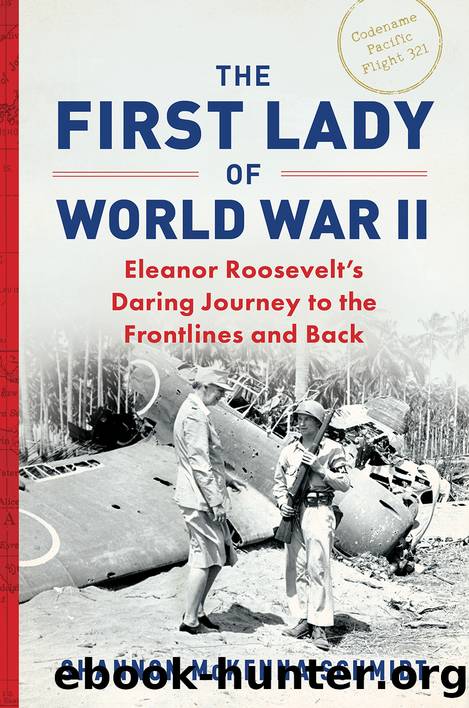The First Lady of World War II by Shannon McKenna Schmidt

Author:Shannon McKenna Schmidt
Language: eng
Format: epub
Publisher: Sourcebooks
Thanking you for your trouble and attention, I remain
Pvt. Donald E. Blount
USMC
P.S. This is the opinion of all the Marines. They back me in all that Iâve said. We donât need women in the Marine Corps.
He found no sympathy with Eleanor, who sent this reply:12
February 6, 1943
Dear Mr. Blount:
Women are proving useful in all branches of the Services.
Donât worry, they wonât bother you!
Very sincerely yours,
Eleanor Roosevelt
The first branch of the armed services to accept women outside nursing rolesâand the only one to send them overseasâwas the U.S. Army. Eleanor backed a bill proposed by Congresswoman Edith Nourse Rogers establishing the Womenâs Army Auxiliary Corps (WAAC), a voluntary enrollment program, which was presented to Congress in May 1941. (The name later changed to the Womenâs Army Corps when members were given full military status.) The bill languished with lawmakers, prompting army chief of staff General George Marshall to demand, âI want a womenâs corps right away, and I donât want any excuses!â13 Congress continued to stall, even after the United States went to war. The bill was delayed due to obstruction by shortsighted congressmen more fearful of how the nationâs laundry would get done than they were about addressing urgent wartime concerns. âWho will then do the cooking, the washing, the mending, the humble homey tasks to which every woman has devoted herself?â14 asked one representative.
Congress finally signed into law the bill establishing the WAAC a year after it was introduced. Recruitment posters appealed to a sense of patriotism, asking, âAre you a girl with a Star-Spangled heart?â while others emphasized a âWomanâs Place in Warâ and promised 239 different kinds of jobs.
âThis is the army behind the fighting forces,â15 said Eleanor after touring a WAAC training center in Des Moines, Iowa.
Even in defense of the nation, there was opposition to breaking down traditional social barriers by having women work outside the home in large numbers. Predictably, Westbrook Pegler ranted against the idea. âMrs. Roosevelt proposed that all of us, men and women, be drafted for war work, which would mean that mothers should be taken out of the homes and the kids taken over by some kind of public mothering authority,â he claimed. âConsidering that broken homes are the main causes of juvenile delinquency and crime I am altogether against this proposal.â16
The Catholic Church also took exception. Catholic World deemed âwomenâs workâ evil primarily for alienating âthe life of the wife from the life of the husband.â The magazine editorial further claimed that women who worked outside the home âweaken family life, endanger their own marital happiness, rob themselves of a manâs protective capabilities, and by consequence decrease the number of children.â17
Nearly everyone expected that women working in the war-production industries would still have to keep up with domestic duties. Eleanor pushed to ensure that women had the necessary resources and support, such as child care, that would allow them to both balance their households and join the assembly lines and that they receive equal pay.
Eleanorâs encouragement of and support
Download
This site does not store any files on its server. We only index and link to content provided by other sites. Please contact the content providers to delete copyright contents if any and email us, we'll remove relevant links or contents immediately.
| Civilization & Culture | Expeditions & Discoveries |
| Jewish | Maritime History & Piracy |
| Religious | Slavery & Emancipation |
| Women in History |
Cecilia; Or, Memoirs of an Heiress — Volume 1 by Fanny Burney(31320)
Cecilia; Or, Memoirs of an Heiress — Volume 3 by Fanny Burney(30927)
Cecilia; Or, Memoirs of an Heiress — Volume 2 by Fanny Burney(30884)
The Secret History by Donna Tartt(16605)
Sapiens: A Brief History of Humankind by Yuval Noah Harari(13035)
Leonardo da Vinci by Walter Isaacson(11891)
The Radium Girls by Kate Moore(10900)
Sapiens by Yuval Noah Harari(4526)
The Wind in My Hair by Masih Alinejad(4420)
How Democracies Die by Steven Levitsky & Daniel Ziblatt(4391)
Homo Deus: A Brief History of Tomorrow by Yuval Noah Harari(4271)
Endurance: Shackleton's Incredible Voyage by Alfred Lansing(3831)
The Silk Roads by Peter Frankopan(3749)
Man's Search for Meaning by Viktor Frankl(3620)
Millionaire: The Philanderer, Gambler, and Duelist Who Invented Modern Finance by Janet Gleeson(3565)
The Rape of Nanking by Iris Chang(3505)
Hitler in Los Angeles by Steven J. Ross(3429)
The Motorcycle Diaries by Ernesto Che Guevara(3325)
Joan of Arc by Mary Gordon(3252)
